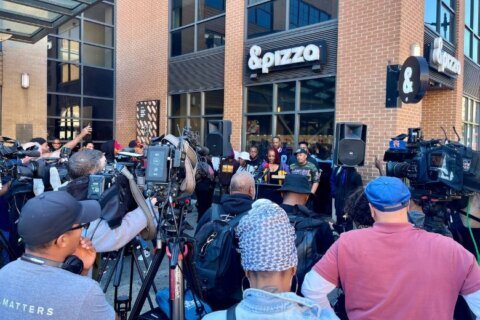This article was republished with permission from WTOP’s news partners at Maryland Matters. Sign up for Maryland Matters’ free email subscription today.
This content was republished with permission from WTOP’s news partners at Maryland Matters. Sign up for Maryland Matters’ free email subscription today.
Because there are fewer state representatives in Pennsylvania within the watershed, it is more challenging for lawmakers in that state to advance policies to restore the Bay, compared to lawmakers in Maryland or Virginia, legislators said during a panel discussion this week.
But demographics is just one factor that affects policymaking.
The three states also have structural differences in their legislative process and levels of local government autonomy, requiring each state to approach the Bay differently in order to effectively restore it.
For instance, Pennsylvania has more than 2,600 different county, city, borough and township governments, while Maryland only has 157 counties, cities and towns with their own governing bodies. The more municipalities, the harder it is to coordinate local resources and move towards a common goal, such as cleaning the Bay, Pennsylvania Sen. Scott Martin (R-Lancaster) said in a webinar about differences in state government hosted by the Chesapeake Bay Commission and Chesapeake Legal Alliance this week.
“You’re going to have — in Pennsylvania’s case — that many more city councils, that many more mayors, that many more personalities and decision making points when it comes to the things that really impact the Chesapeake Bay,” Maryland Sen. Sarah Elfreth (D-Anne Arundel) said.
“When it comes to any kind of land use policy, storm water regulation — that extra layer of bureaucracy and bringing in all those municipalities around a centralized policy — I think it’s just an added pressure point,” she continued.
Framing policies around common issues like clean water and watersheds that more Pennsylvania lawmakers can coalesce around, rather than building coalitions only with those in the Bay watershed, will bring more lawmakers on board and ultimately lead to programs that benefit the Bay, Martin said.
But even though Pennsylvania does not directly border the Bay, it has 85,000 miles of streams, making it a state with the second highest stream density in the country, according to Molly Brown, senior attorney of the Chesapeake Legal Alliance. The Delaware Bay watershed also lies on the east of Pennsylvania, the Ohio River watershed in the west and the Lake Erie watershed in the north.
“I think where I started to see the tide turn, where people really started to care about issues surrounding water, wasn’t necessarily when we’re talking about the Chesapeake Bay,” Martin said. “When you started talking about clean water in our own waterways, that’s where, over time, that the conversation started to shift.”
Maryland lawmakers may have an easier time coming together on laws relating to the Bay, but Elfreth says she still has to convince lawmakers in counties such as Montgomery and Howard that what they are doing upstream impacts what happens downstream.
In Virginia, a “Dillon Rule” state, local governments have only those powers granted by the state.
Maryland and Pennsylvania are “Home Rule” states, which give local governments more autonomy.
Legislators need to think about what kind of authority they are granting localities, such as writing legislation broadly so that localities can decide what is best, said Virginia Del. David Bulova (D-Fairfax), the chairman of the Chesapeake Bay Commission. Virginia’s Chesapeake Bay Preservation Act is “very broad” and often not used to full advantage, he said.
The three states also differ in their number of legislative districts, which affects lawmakers’ keenness to compromise. Maryland has 47 Senate subdivided into 67 House districts, Pennsylvania has 50 Senate districts and 203 House districts and Virginia has 40 Senate districts and 100 House districts.
The smaller the district, the less willing legislators may be to compromise and work with others who do not represent similar spaces, Elfreth said.
The states also have different budgetary processes that involve different ways to attain funding for Bay restoration. For instance, the Maryland General Assembly cannot move money between departments or increase the budget. Rather, its main power with the budget bill is to reduce or delete proposed appropriations from the governor.
In Virginia, an incoming governor and a new general assembly deliberate on a budget proposal made by the outgoing governor, because Virginia’s budget is passed every two years. “It can leave the new governor really kind of scrambling to figure out what their priorities are,” Bulova said.
The supplementary appropriation bills, or capital budget bond bills, are how most projects that contribute to the Chesapeake Bay Restoration are funded, Brown said.
In Pennsylvania, where only the middle third of the state lives in the Bay watershed, it is important that any statewide funding for water quality be multiplied by three so that there is enough funding for the Bay watershed and the rest of the state, Brown noted.
Although the three states tackle policies relating to the Bay restoration differently due to structural political differences, they can still exchange ideas and motivate one another toward the common goal of restoring the Bay, Elfreth said. When Virginia passes a piece of legislation one year, it’s not uncommon to see it influence Pennsylvania and Maryland to pass a similar bill the next year, she added.
“In the watershed, recognizing these arbitrary political boundaries between counties and states… we really do have to focus harder, stop pointing as many fingers…and frankly, get into rooms, perhaps over an alcoholic beverage, and try to work out these challenges that are kind of shared amongst us,” Elfreth said.







